TIAHUANACO AND THE DELUGE
By Helmut Zettl
Cradled in the basin of the Peruvian-Bolivian altiplano, the Titicaca region is currently densely populated by the Aymara Indians, who eke out an agricultural existence, subsisting primarily on maize, frozen potatoes, and chicha, a fermented alcoholic beverage made of cornmeal.

But there is evidence that such was not always the case. Just 12 miles southward of the southernmost tip of Lake Titicaca lie the remains of Tiahuanaco, the site of a technologically advanced culture considered by many archaeologists (romantic not orthodox) to be the oldest ruins in the world. Although some misguided scholars have attributed the buildings of Tiahuanaco to the Incas, it has now been established that the city was already in ruins when the first Incas came upon the scene.
In 1540 the Spanish chronicler, Pedro Cieza de Leon, visited the area and his description of the statues and monoliths compares very closely to what we see today.
The site is at an altitude of 13,300 feet, which places it some 800 feet above the present level of Lake Titicaca.
Most archaeologists agree that in the distant past Tiahuanaco was a flourishing port at the edge of the lake, which means that the water has receded almost 12 miles and has dropped about 800 feet since then. All concur that the lake is shrinking, due mainly to evaporation, since no rivers flow from it.

The Tiahuanaco culture, as it is called, is unique in its sculpture and its style of stone construction.
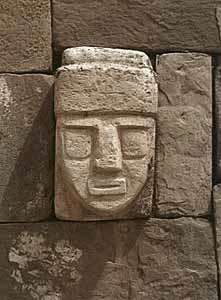
The figures depicted in the statuary have a rather square head with some covering like a helmet; they have square eyes and a rectangular mouth.
The stone works at the ruins consist of such structures as the Gate of the Sun, a portal carved from a single block of stone weighing 15 tons.
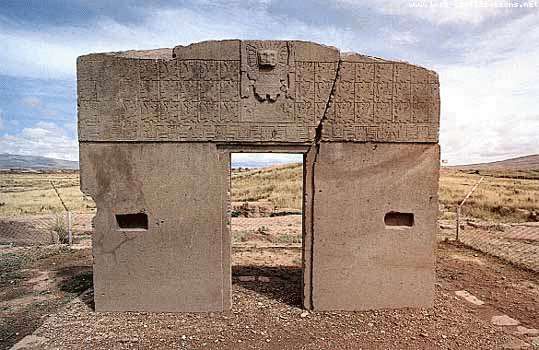
The stone steps of the Kalasasaya, each of which is a rectangular block of stone about 30 feet wide.
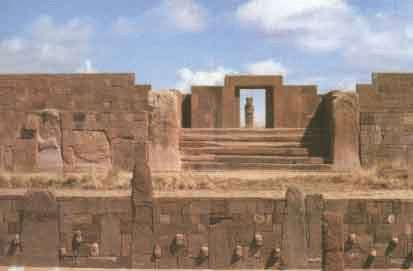
The so-called idols, which are giant about 23 feet tall representatives of unusual looking beings with typical Tiahuanaco head and trace, and the enormous monolithic stone blocks, many of which appear to have been cast rather than carved, are some of these unusual features.
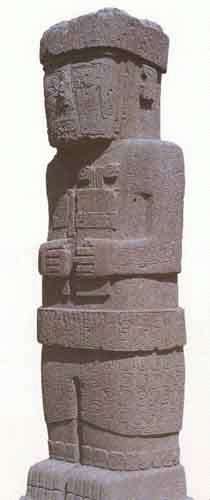
At the area called Puma Punku, which is about 1 mile distant from the principal part of the ruins, the gigantic stones are bluish-gray in color and appear to have been machined, and they have a metallic ring when tapped by a rock.
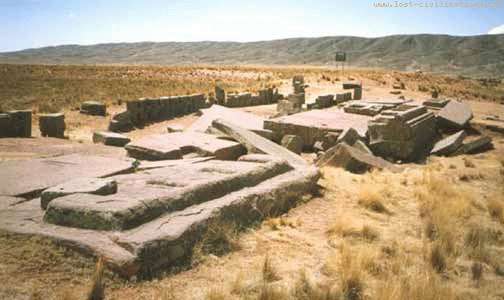
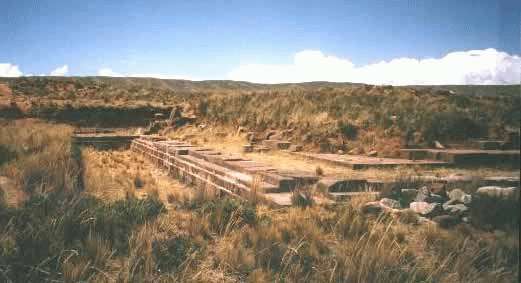
There is also a reddish rust or oxidation covering many of the stones. Many of these enormous stone blocks probably have not been moved since they fell thousands of years ago. Archaeologists however speculate that the stones were dressed, but never erected that the construction for which they were intended was interrupted.
It is equally valid, however, to assume that the buildings were completed and then toppled by some natural catastrophe, such as the eruption of the Andes mountain chain or a world-wide deluge.
It is interesting to observe the archaeological excavation work, which is under way at the site. At this altitude of 13,300 feet some of the remains are found at a level 6 feet below the earth’s surface. The mountain ranges which surround the area are not high enough to permit sufficient runoff of water or wind erosion to have covered the ruins to such a depth.
This remains a mystery to this day.
Legends have persisted over the centuries that there are stone structures beneath the waters of Lake Titicaca, much the same kind as can be found on the lake’s shore.
The Indians of that legion have frequently recounted this tradition, but until recently there has been no proof of such structures.
In 1968 Jacques Cousteau, the French underwater explorer, took his crew and equipment there to explore the lake and search for evidence of underwater construction.
Although severely hampered in their activities by the extreme altitude, the divers spent many days searching the lake bottom, in the vicinity of the islands of the Sun and Moon, but found nothing man-made. Cousteau concluded the legends were a myth.
In November 1980, however, the well known Bolivian author and scholar of pre-Columbian cultures, Hugo Boero Rojo, announced the finding of archaeological ruins beneath Lake Titicaca about 15 to 20 meters below the surface off the coast of Puerto Acosta, a Bolivian port village near the Peruvian frontier on the northeast edge of the lake.
Based upon information furnished by Elias Mamani. a native of the region who is over 100 years old, Boero Rojo and two Puerto Ricans cinematographers, Ivan and Alex Irrizarry, were able to locate the ruins after extensive exploration of the lake bottom in the area, while filming a documentary on the nearby Indians.
Rojo stated, “We can now say that the existence of pre-Columbian constructions under the waters of Lake Titicaca is no longer a mere supposition or science-fiction, but a real fact. The remnants found show the existence of old civilizations that greatly antecede the Spanish colonization. We have found temples built of huge blocks of stone, with stone roads leading to unknown places and flights of steps whose bases were lost in the depths of the lake amid a thick vegetation of algae. Boero Rojo described these monumental ruins as being of probable Tiahuanaco origin.”
Polish-born Bolivian archaeologist Arturo Posnansky has concluded that the Tiahuanaco culture began in the region at about 1600 B.C. and flourished until at least 1200 A.D.
His disciple, Professor Hans Schindler-Bellamy, believed Tiahuanaco to have reached back 12,000 years before the present era, although a more conservative Peruvian archaeologist.
What happened to the advanced ancient culture, however, has not yet been determined.
Rojo’s discovery nevertheless may prove to create more problems than it solves. If, over the past 3 or 4000 years Lake Titicaca has slowly receded, as appears to be the case-as all scientists agree, then how can we explain the existence of stone temples, stairways, and roads still under water’?
The only answer is that they were built before the lake materialized.
We must go back, then, to the remnants of Tiahuanaco and re-examine the more than 400 acres of ruins, only 10 percent of which have beenexcavated.
We have pointed out that dirt covers the ancient civilization to a depth of at least 6 feet.